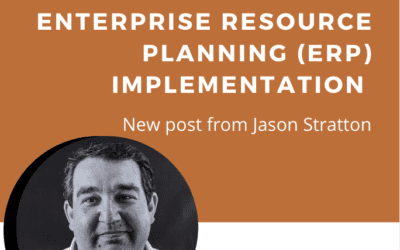It is common for manufacturers to reconsider their use of space for a number of reasons, including an expiring lease, outgrowing the existing space due to new products or increased sales, the addition of new technology / equipment, or the need to consolidate to a smaller footprint.
Good news: there are options for solving all sorts of space challenges. whether your goal is a smart reorganization of currently available space, you’re making the move to another location, or developing a new greenfield parcel for a purpose-built building –below are some important (and often overlooked) considerations.
Every Physical Change or Process Change Starts with Lean
While there are many ways to approach the perceived need for a facility re-layout or move, intuition and gut instinct can be less reliable than looking at the numbers. Ideally before any physical processes are moved, the current state has been mapped and work has been done to create flow within the conditions of the current facility.
This could mean tackling projects in work balancing, scheduling, point of use inventory, work simplification, and inventory management to name a few. Once this work has been done, a good understanding of several things should emerge:
- Key processes that are important to keep in-house;
- Analysis on make vs. buy decisions for items that take up space and time to produce but might not be critical to producing in-house;
- Physical space requirements for each work cell and its inventory;
- historical market information that is useful for scheduling the production and projecting market demand into the future.
All of these, among others, will play a critical role in any re-layout. OMEP would caution against facility re-layout without some work being done on these items.
What is Driving Your Facility Re-Layout Need?
- Is the business experiencing booming demand for product, and will that demand sustain or fade due to different market conditions next year?
- Does the business need more space on account of COVID precautions?
- If so, adding a second or even third shift might be a quicker option than moving the business to a larger space.
- Does the business need to reorganize within the current space to reduce wasted travel and movement?
- Does the business need more space because slower inventory turns are crowding out production space?
- Does the business need to acquire new equipment that cannot be accommodated in the current space?
- Is the lease expiring on the current facility and can it be renegotiated during this time when COVID has impacted the corporate and industrial real estate market?
Having a clear and firm understanding of why the business needs to modify it’s space is a crucial piece of the puzzle when it comes to planning for a successful re-layout.
Planning for growth- know the market that you think you can capture for your region; develop a manufacturing strategy that meets the business goals
A company that is considering an increase in space due to surging demand for their product would be wise to do some market analysis. Think strategically about the amount of market share you believe can be captured for the region you serve. A useful next step could be to develop a 5-year manufacturing strategy that targets capacity and growth based on market share projections, and any added products. Don’t make the move until you’ve spent some time with the numbers to be sure that your plan provides for the mechanisms, staff, and structure that will meet your expected demand.
Consider Constraints
Make a list of all constraints to be considered. Common constraints we hear from companies considering re-layout:
- Capital and finances
- Existing lease agreements
- Existing space constraints, like available utilities and head room
- Regulatory code requirements
- Seasonality of the market and need to be ready for the next big cycle
- Unacceptable disruptions to current production
- Proximity to your customer base
Make a plan
Assemble the analysis that the team has completed and make some macro-level decisions.
Will the business stay in place and reorganize to make better use of it, or will the business seek a new home? Often times, at OMEP, we get calls at this phase to help companies execute on their ideas. While momentum can be strong toward a particular solution, if it is palatable to the company, we would recommend stepping back a few steps to make sure these other parts have been considered.
Roughout a project plan with a timeline for the rest of the activities (design; prep for move; move; testing and validation of the new layout)
Assemble A Design Team that Includes the Staff Doing the Work
With the major decisions like location and budget decided, assemble a design team that is small enough to be nimble and yet large enough to gather from the best ideas available about how to layout the space. Have a team lead that keeps the process moving – often times this is the role that OMEP plays. If possible, include either a seasoned employee or current production lead who can forecast how the changes will affect their work. This also serves the role of getting the shop’s buy-in on the changes, which without, any new layout will not be sustained.
Get out of the Box in your Thinking About Future-State
Often, the design team’s creativity can be bounded by their experience of working in the current environment. In this situation, OMEP’s role is to push the team to be bold in their ideas of how to re-layout the space. OMEP also draws on experiences of working with many different manufacturers who have faced and solved similar challenges that the design team is working through. Out of the box solutions can result in staggering efficiency gains and become the company’s operational advantage over competitors. The process could change in this phase altering how work is balanced and nested within stations. Staffing requirements will likely change as a result.
New Machinery, Technology, and Fixtures
The event of a physical move is a good time to consider whether the company is using the right tools and fixtures for the current state. Are there different tools and machinery available that will help the company meet its capacity goals? Are there new fixtures needed to present the work? The design team may dream up fixtures or tooling that isn’t available off the shelf and needs to be specially designed and fabricated. This is work that OMEP can help with. A facility relayout could also be the right time to incorporate new technology like a collaborative robot or adding IoT sensors to different parts of the process. If you could measure parts of the process, what would you measure and how would it help you.
Plan for Flexibility into the Future
When designing and planning for the future state, keep an eye on flexibility. This means, when it comes to choosing machinery, when possible avoid spec’ing machinery in ways that it will become an unmovable monument. Avoid building a building that is so specialized it will have a hard time being repurposed. Avoid cutting into floors and adding pits.
3D Layouts or 2D Paper Doll Layouts to Test Out Ideas
Fail fast, fail cheap is a saying that we use at OMEP. It means that before committing to costly changes, try on the ideas by simulating them to the best of your ability. For facility layouts, it’s always a good idea to create a scaled model in 2D or 3D to help visualize material movements, product movement, staff working areas, and upstream/downstream effects of physical layout changes. At OMEP we do both 2D and 3D layouts of factories, based on the needs of the project.
Designing for efficient facility layout is about balancing tradeoffs of cost, time, and complexity in pursuit of the best layout for a company’s needs.
If you need assistance with your re-layout, or are moving to a new facility, feel free to reach out to our team for support.
I’ll be sharing part 2 of this blog post shortly: How to use 3D modeling to re-layout existing manufacturing space and new buildings.




